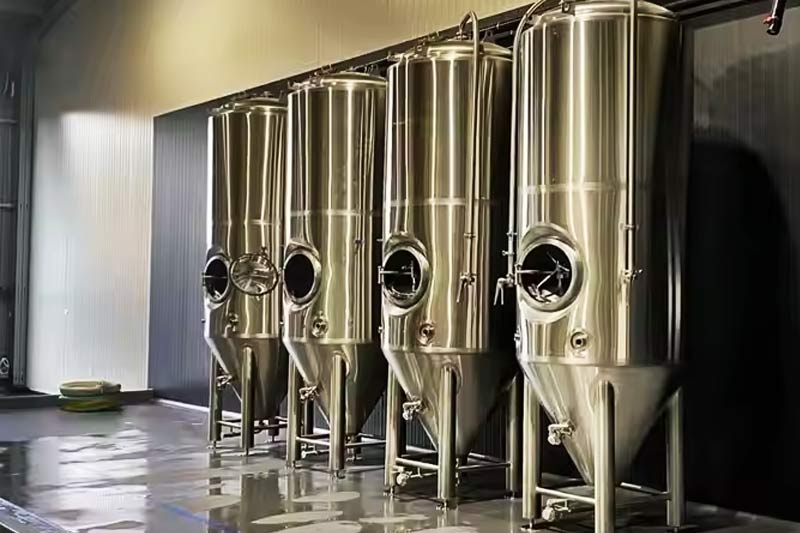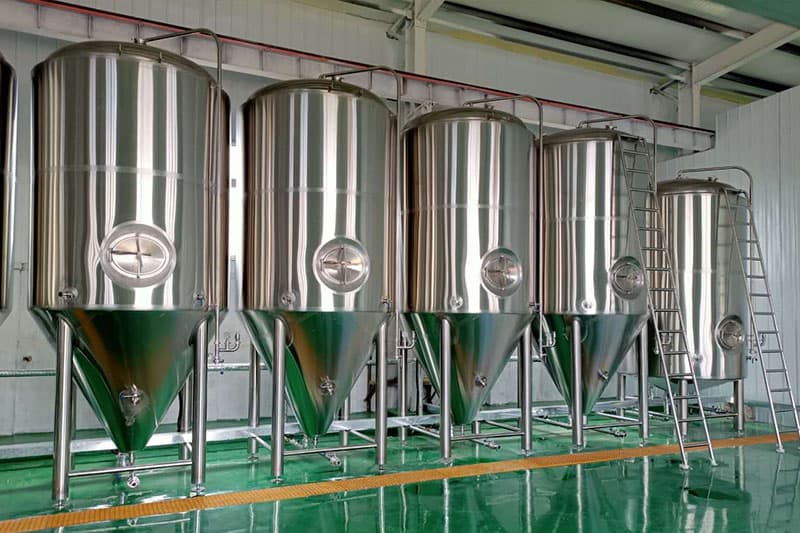What is a Beer Fermenter?
A beer fermenter is a key tool in making beer. It holds wort and yeast while they turn into beer. This is where the magic happens!
Beer fermenters come in many shapes and sizes. The most common types are:
- Plastic buckets
- Glass carboys
- Stainless steel tanks
Each fermenter has parts that help make good beer:
- An airlock to let gas out but keep air away
- A lid that seals tight
- Ports for adding things or taking samples
The brewing steps are simple:
- Clean the fermenter
- Add cooled wort
- Add yeast
- Seal it up
- Wait for fermentation

Types of Beer Fermenters
Are you feeling lost with all the fermenter choices? Many brewers face this same problem. With so many options, how do you know which one is right for your beer?
The wrong fermenter can lead to off-flavors, stuck fermentation, or even spoiled batches. This means wasted time, money, and ingredients. Nothing feels worse than dumping a batch you’ve spent weeks working on!
This is where a quality fermenter makes all the difference. The right vessel not only prevents these issues but enhances your beer’s flavor and consistency. Stainless steel fermenters offer superior protection against oxygen exposure and contamination while providing excellent temperature stability.
Fermenter Type Comparison
| Type | Cost | Pros | Cons | Best For |
|---|---|---|---|---|
| Plastic Bucket | $15-30 | Cheap, Light, Easy to clean | Scratches easily, Limited lifespan (5-8 years) | Beginners |
| Glass Carboy | $30-50 | See-through, No taste transfer | Heavy, Breakable, Hard to clean | Visual monitoring |
| Stainless Steel Conical | $200-2000+ | Durable (15-20 years), Easy to clean, Temperature control | Expensive, Heavy | Serious brewers |
| Unitank | $500-5000+ | All-in-one fermenting/carbonating | Very expensive, Complex | Commercial brewers |
Plastic buckets are good for beginners, but they can scratch. Those scratches hide bacteria that can spoil beer.
Glass carboys let you see the beer but are heavy and can break.
Stainless steel is the best choice for most brewers. It lasts longer and is easy to clean. As the market data shows, stainless steel fermenters achieve 40% higher material reuse compared to plastic options.
How to Choose the Best Beer Fermenter
Picking the right fermenter is hard. You might waste money on one that doesn’t fit your needs. Or worse, you could end up with bad beer!
Think about how much beer you want to make. Small batches need small fermenters. Big batches need big ones.
The material matters too. Plastic is cheap but can scratch. Glass is good but heavy. Stainless steel is the best but costs more.
Here are the key things to look for:
- Size: Match to your batch size (1, 5, or 10 gallons)
- Material: PET plastic, glass, or stainless steel
- Shape: Bucket, carboy, or conical
- Features: Temperature control, sampling ports, pressure capability
- Budget: From $30 to $500+
Top 2025 Beer Fermenter Picks
Best Budget Option: Fermonster PET Carboy
- Price: $30-40
- Pros: Big opening, light, see-through
- Cons: Can scratch, shorter life
Best Mid-Range: SS BrewBucket
- Price: $200-250
- Pros: Stainless steel, small conical bottom
- Cons: No pressure fermenting
Best Premium: Spike Flex+
- Price: $450-500
- Pros: Full stainless steel conical, pressure capable
- Cons: Heavy, needs more space
Many new brewers start with plastic but soon want to upgrade. Nano brewery systems often use multiple stainless steel fermenters for maximum efficiency.

Step-by-Step Fermentation Guide
Have you ever brewed a batch that just didn’t turn out right? You followed the recipe perfectly, but something went wrong in fermentation. The beer tastes “off” or fermentation stalled halfway through.
This common problem frustrates both new and experienced brewers. Without proper fermentation control, you risk creating beer with unwanted flavors, incorrect alcohol levels, or even contamination that ruins the entire batch.
The solution is a systematic approach using quality equipment. With proper fermentation management, you can produce consistently excellent beer every time. Here’s how the pros do it:
1. Sanitize Everything
- Use Star San or iodophor
- Don’t rinse after sanitizing
- Let things air dry
2. Transfer and Pitch Yeast
- Cool wort to the right temperature (65-70°F for ales)
- Add yeast at the right temperature
- Seal fermenter right away
3. Manage the Airlock
- Fill airlock with sanitizer or vodka
- Check it daily for activity
- Replace if it dries out
4. Control Temperature
- Keep ales at 65-70°F
- Keep lagers at 45-55°F
- Avoid temperature swings
5. Cold Crash (Optional)
- Chill to 35-40°F for 24-48 hours
- Helps clear beer
- Do this before bottling
Using a temperature controller with your fermenter makes a big difference. It keeps the beer at just the right temperature for the yeast.
Maintenance & Troubleshooting
Cleaning your fermenter is very important. A dirty fermenter can ruin your beer!
Cleaning Tips:
- Rinse right after use
- Use PBW or baking soda for tough stains
- Use a soft cloth for plastic
- Use bottle brushes for hard-to-reach spots
- Always sanitize before next use
Common Problems and Fixes:
| Problem | Cause | Solution |
|---|---|---|
| No bubbling in airlock | Leaky seal or slow fermentation | Check lid seal, be patient |
| Strange smell | Infection or normal yeast smell | Check for visible mold, often normal |
| Stuck fermentation | Too cold, old yeast, not enough nutrients | Warm up, add fresh yeast |
| Off-flavors | Temperature issues, contamination | Control temperature better, improve cleaning |
| Mold on top | Contamination | Dump batch, improve sanitation |
Many breweries face the challenge of keeping equipment properly sanitized while maintaining production schedules. This is where professional-grade cleaning systems become essential. With proper maintenance, stainless steel fermenters can last 15-20 years, making them a sound investment for serious brewers.

Advanced Techniques
Once you master basic fermentation, you can try these cool techniques:
Pressure Fermentation
- Ferment under 5-15 PSI pressure
- Creates cleaner flavors
- Needs special fermenter with spunding valve
- Reduces off-flavors
According to market research, advanced bioreactors reduce energy use by 35% in industrial brewing settings. These innovations are now becoming available to smaller craft operations.
Yeast Harvesting
- Save yeast from one batch for the next
- Works best with conical fermenters
- Save money on yeast
- Build your own yeast bank
Glycol Cooling
- Uses special cooling jackets
- Keeps temperature perfect
- Common in big breweries
- Now available for home use
Oak Barrel Aging
- Adds wood flavors
- Needs special care
- Creates unique beers
The best part about advanced techniques is that they help you make better beer. Many craft beer equipment setups now come with these advanced features built in.
Brewing Equipment Market Overview
| Market Growth (CAGR) | 6.3% |
| Stainless Steel Lifespan | 15-20 yrs |
| Energy Savings | 35% |
FAQ About Beer Fermenters
Q: Can I reuse plastic fermenters?
A: Yes, but replace them after 10-15 batches or if they get scratched.
Q: Do I need secondary fermentation?
A: Not always. It helps with lagers and big beers but can add oxygen risk.
Q: How long does fermentation take?
A: Ales take 1-2 weeks. Lagers take 3-6 weeks.
Q: Is airlock bubbling a good sign?
A: Yes, but no bubbling doesn’t always mean problems. Trust your hydrometer.
Q: What’s the best fermenter for beginners?
A: A 6.5-gallon plastic bucket fermenter is best for starting out.
Q: How do I prevent oxidation during transfers?
A: Use closed transfer methods with CO2 to push beer, not air.
Making the Right Choice
Choosing and using a beer fermenter can seem hard. But with the right knowledge, you can make great beer at home.
Start with something simple like a plastic bucket if you’re new. Move up to stainless steel when you’re ready.
The most important things are:
- Keep it clean
- Control temperature
- Use good ingredients
- Be patient
With these tips, you’ll be making amazing beer in no time!
In the fast-evolving craft beer industry, having the right equipment makes all the difference between average and exceptional beer. The global bio-fermenter market is projected to grow at 6.3% CAGR through 2032, driven by rising demand for quality brewing equipment.
For brewers looking to take their craft to the next level, partnering with an experienced manufacturer can eliminate the guesswork. With over 15 years of industry experience and a deep commitment to quality, some suppliers offer comprehensive brewing solutions that include custom fermenter designs to match your specific brewing style and goals.
The best equipment providers offer not just products but complete solutions—from brewery design to ongoing technical support. With service centers across multiple continents and experienced teams that understand both the art and science of brewing, these partners can help ensure your investment produces the best possible results. Look for manufacturers offering meaningful warranties (like 3 years on tanks) and a proven track record of successful installations across many countries.
Whether you’re just starting your brewing journey or expanding an established operation, the right fermenter is the heart of your brewery. Choose wisely, and your beer—and customers—will thank you.
